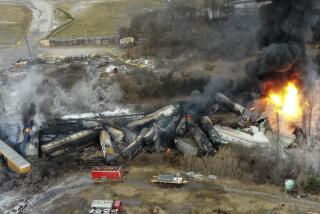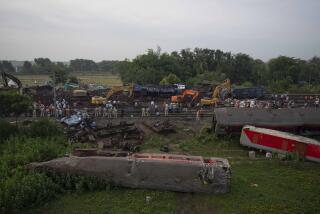Train Ignored Signals, Crash Probers Allege
- Share via
WASHINGTON — The engineer of the Conrail train that rolled into the path of a high-speed Amtrak train, killing 15 persons, ran at a steady 60 m.p.h. through two signals telling him to slow down, sources close to the investigation said Wednesday.
The engineer threw on his brakes about a half mile before Sunday’s fatal impact when he realized he was approaching a stop signal, the sources said.
The trip of the Conrail freight locomotive described by investigators seemed ill-fated from the beginning, with no working locomotive radio and two disabled safety mechanisms in the cab. The outside signals indicating speed limits, however, were working properly, the investigators said.
Even if the engineer had heeded the signals he claims to have seen, he would have had time to bring his train to a stop before sliding onto the main line in front of the Amtrak train, they said.
Engineer Unavailable
The engineer, R.L. Gates, was interviewed extensively by federal investigators Wednesday. He was unavailable for comment, but his lawyer, Stephen Tully, said Wednesday night that Gates responded properly to the signals and was not at fault.
After a late-evening press briefing, chief National Transportation Safety Board investigator John Rehor said he was “quite impressed” with Gates, describing him as “a fine-looking young man” who “was very composed and intellectual.” Rehor said that Gates scored 100% on a safety rules examination this year, that he has 20-20 vision, and that he had an unblemished record.
Amtrak resumed normal service north from Washington on Wednesday for the first time since the crash, the worst in Amtrak history. Of the 170 injured in the crash, at least 12 remained hospitalized.
In an earlier statement, Gates told investigators that he saw the outside signals, according to sources. He said one of the signals, almost two miles from the crash site, gave him a false reading, telling him he was clear to proceed through the switch where the two trains collided.
Be Prepared to Stop
Investigators said a preliminary check of the signal system showed that the signal actually instructed Gates to slow down to 30 m.p.h. and be prepared to stop at the point where his tracks merged with the tracks the other train was on. They said the Conrail train should have been traveling no more than 15 m.p.h. when it approached a final signal--known as the “home signal”--384 feet before the tracks merge.
Investigators said that even if Gates had gotten the instructions he said he saw on the first signal, he should have slowed to 40 m.p.h. At that speed, they said, he would have been able to stop in time when he saw the home signal’s stop instruction nearer the switch.
A locomotive simulator, they said, indicated that the Conrail locomotive, a General Electric B36, and the two identical locomotives coupled to it, would have slid 2,150 feet if the emergency brakes were applied at 60 m.p.h.
Train Slides 2,160 Feet
That is almost exactly what happened, according to the tapes from the locomotive: the freight train slid 2,160 feet after Gates applied the brakes. Although tests have not yet been run on stopping distances for that particular type locomotive at 40 m.p.h., a test on a different type of locomotive placed its stopping distance at less than 800 feet.
“There’s no question he could have stopped (at 40 m.p.h.),” said an investigator.
Meanwhile, the Federal Railroad Administration said Wednesday it will seek civil penalties against Amtrak because the railroad failed to test all surviving crew members for drugs and alcohol after Sunday’s collision near Baltimore.
The agency said drug and alcohol tests are vital to rail accident investigations, although in the Amtrak collision the consequences of not testing everyone are expected to be minimal since the crew members involved were not operating the train.
The maximum penalty for violating the federal testing regulations is $2,500 per violation for each of the three crew members not tested.
More to Read
Sign up for Essential California
The most important California stories and recommendations in your inbox every morning.
You may occasionally receive promotional content from the Los Angeles Times.













